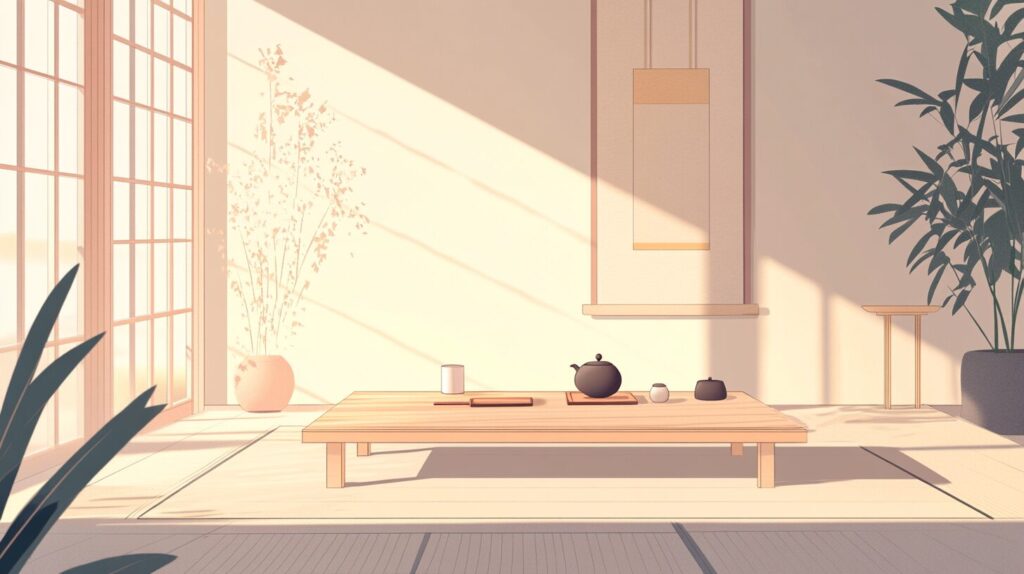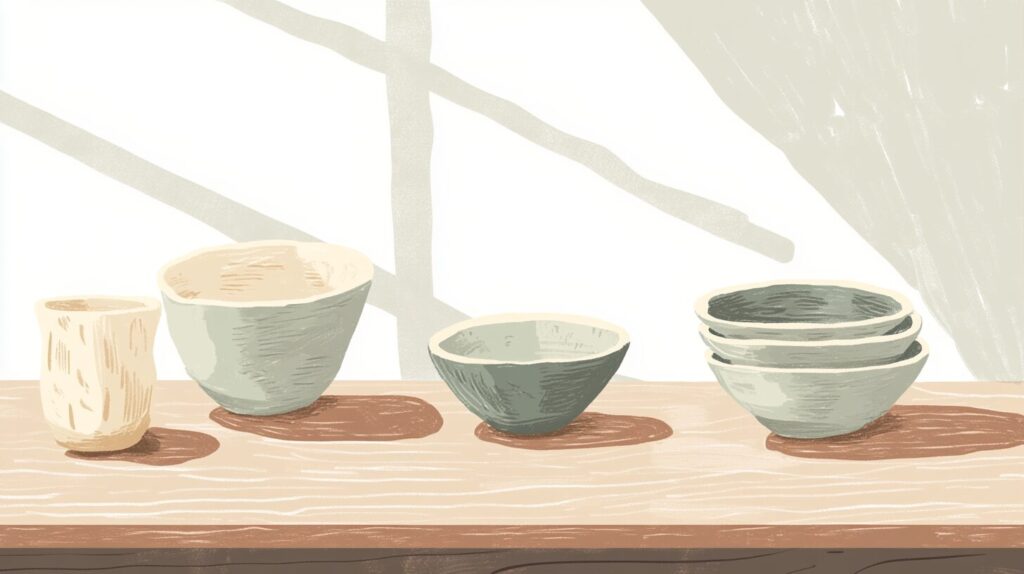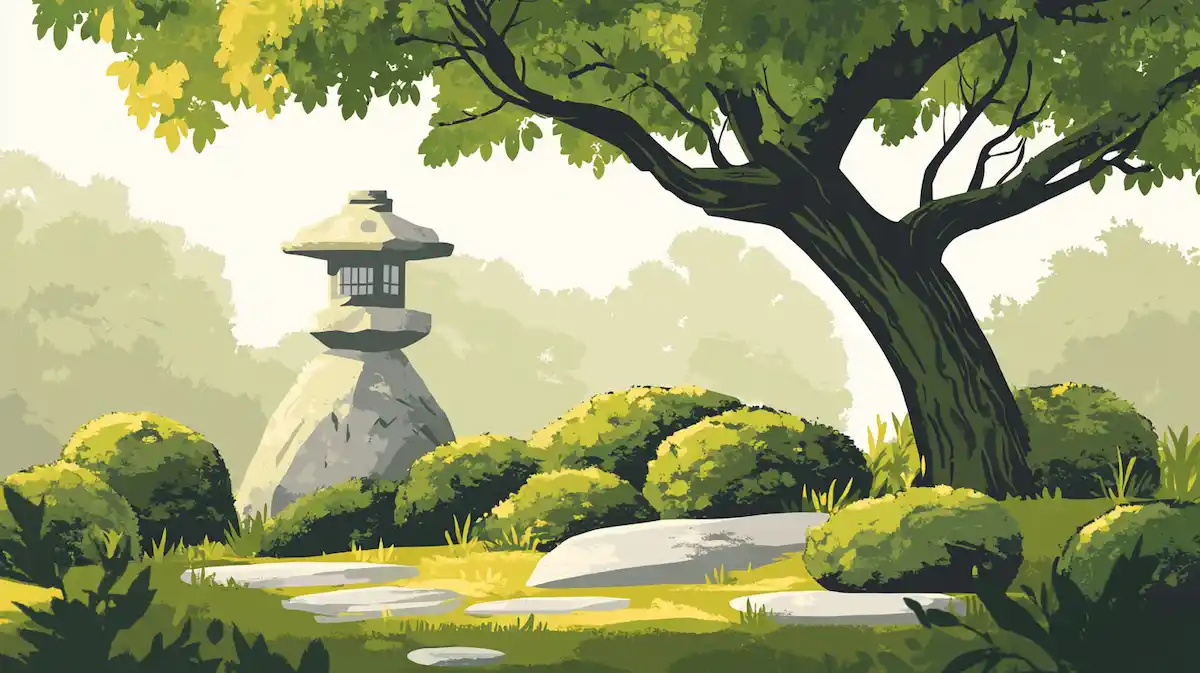わびさびを英語で説明・紹介するための基本情報と、英会話に役立つ表現をシンプルでわかりやすい英語で紹介します。
英会話ダイアローグ・関連情報・10の質問を通して、日本独特の美意識のわびさびに関する英語表現を学びます。
英語
英会話ダイアローグを読む前に知っておくと良い前提知識と情報です。
- わびさびの基本
- わび: 質素さや控えめさを重んじ、物質的な豊かさよりも静かでシンプルな美しさを大切にする考え方
- さび: 時間の経過や自然な劣化に美を見出し、古くなったものや変化するものに価値を見出す考え方
- わびさびの魅力: 完璧さではなく、不完全さや自然の美しさを尊重し、日常の中に深い感動を見つける
- 歴史と背景
- わびさびを表現する芸術
- 現代でのわびさびの人気
- ミニマリズムとの共通点: シンプルで余分なものを排除するライフスタイルと重なり、世界中で注目を集めている
- 自然と調和: 忙しい現代生活の中で、心を落ち着け、自然との調和を取り戻す手段として評価されている
2人がわびさびについて話しています。
「わび」の質素な美しさ、「さび」の経年変化の価値など、日本伝統の美学のわびさびの魅力、茶道との関係、わびさびを表現する芸術などを話題にしています。
会話 / dialogue

Hey Key, I’ve been thinking a lot about “wabi-sabi” lately. I find the idea of finding beauty in imperfection really interesting, but I feel like I don’t fully understand it yet. What do you think?

Oh, “wabi-sabi” is fascinating! It’s all about appreciating simplicity, naturalness, and the idea that nothing lasts forever. It’s a really deep concept that’s hard to grasp at first, but once you do, it changes the way you see things.

Yeah, that’s what caught my attention. I know it’s important in things like the tea ceremony, right?

Exactly. The tea ceremony is probably one of the best examples of “wabi-sabi” in practice. Sen no Rikyu, a famous tea master, made it popular in the 16th century. He believed that real beauty could be found in simplicity, like using a rough, imperfect tea bowl.

That’s interesting! So, the tea ceremony isn’t just about drinking tea, but more about experiencing this sense of simplicity and imperfection?

Right. It’s about being in the moment, appreciating the small details, and accepting that things aren’t perfect, which is the essence of “wabi-sabi.” The tea bowls, for example, often have cracks or uneven shapes, but those imperfections make them more beautiful.

I see. It sounds like “wabi-sabi” is present in other forms of art, too?

Yes, definitely. You can find it in pottery, like Raku ware, which is known for its simple, handmade look. Japanese gardens also express “wabi-sabi” by using natural elements like stones and moss, and letting nature take its course.

And I guess that “wabi” emphasizes simplicity, right? Like the idea of finding peace in modest, quiet things?

Exactly! “Wabi” is about appreciating things that are plain and humble, like a quiet, simple lifestyle. It’s about finding beauty in small, everyday moments, rather than in luxury or perfection. It’s a way of life that values peacefulness over materialism.

That’s a nice contrast to how most people think about beauty. It makes me think more about the quiet moments in life that we often overlook.

Yes, and that’s the beauty of “wabi.” It teaches you to slow down and appreciate simplicity, like a solitary moment in nature or a well-used, but simple object. Combined with “sabi,” which emphasizes the beauty of aging and change, you get a complete picture of “wabi-sabi.”

I’ve seen those gardens. They feel peaceful and timeless. I guess that’s another aspect of “wabi-sabi,” appreciating the passing of time?

Exactly. “Sabi” refers to the beauty of aging and change. For example, the way wood weathers over time or how a rusted metal object gains character—that’s “sabi.” It’s about embracing the natural process of things getting old.

That makes sense. So, it’s really about accepting that things are temporary and imperfect, but finding beauty in that?

Yes, and that’s what makes “wabi-sabi” so special. It’s not about striving for perfection but appreciating things as they are. This can also bring a sense of peace to your life because you’re not always chasing after something better.

I like that. It reminds me of how some pottery pieces are intentionally left imperfect. Like, they’re cracked or not perfectly round, but that’s what makes them beautiful.

Exactly! In fact, this idea is really popular today, especially with the rise of minimalism and simple living. People around the world are drawn to the idea of “wabi-sabi” because it encourages us to focus on what’s essential and appreciate natural beauty.

I can see why. There’s something calming about it, especially in a fast-paced world. Do you think that’s why “wabi-sabi” has become so popular recently?

Yes, definitely. People are looking for ways to slow down, simplify their lives, and reconnect with nature. “Wabi-sabi” offers a way to do that by reminding us that it’s okay to be imperfect and that aging or change can be beautiful.

I’m really starting to appreciate that mindset. It makes me want to learn more about “wabi-sabi” and see how I can apply it in my daily life.

That’s great! You can start by paying more attention to small details, like the way sunlight falls on an old piece of wood or how your favorite cup has aged over time. It’s all about noticing and appreciating the beauty in the everyday things around you.

I’ll try that. It sounds like a nice way to bring more calm and appreciation into life. Thanks for explaining it so clearly, Key. I feel like I understand “wabi-sabi” a lot better now.

Anytime, Mack! It’s such a rich concept, and the more you think about it, the more you’ll start to see it everywhere in Japanese culture.
関連情報 / related information
「わびさび」について、理解を深めるための「英語での関連情報」です。
わびさび

What is Wabi-Sabi?
“Wabi-sabi” is a Japanese idea that values beauty in simplicity and imperfection. It teaches that things don’t need to be perfect to be beautiful. Instead, we should appreciate natural flaws and the passage of time. “Wabi” focuses on finding peace in simple, modest things, while “sabi” sees beauty in aging and the changes that come with it.
History of Wabi-Sabi
The idea of wabi-sabi comes from Zen Buddhism and was made popular in the 16th century by a tea master named Sen no Rikyu. He believed that simple, handmade tea bowls with cracks or uneven shapes were more beautiful than perfect ones. The tea ceremony is one of the best ways to experience wabi-sabi.
Wabi-Sabi in Art
Wabi-sabi is also found in other traditional Japanese arts, like pottery, gardens, and calligraphy. In pottery, for example, pieces with rough textures or imperfections are highly valued. Japanese gardens use natural elements like moss and rocks to show the beauty of nature. In calligraphy, the flow and simplicity of the strokes express wabi-sabi.
Why Wabi-Sabi is Popular Today
Today, wabi-sabi is popular around the world because it encourages people to slow down, simplify their lives, and find beauty in the ordinary. It’s a calming philosophy that helps people appreciate the small and imperfect moments in life.
10の質問 / 10 questions
「わびさび」について、理解を深めるための「英語での10の質問」です。
1: What is wabi-sabi?
Wabi-sabi is a Japanese concept that values simplicity and imperfection, finding beauty in things that are natural and incomplete.
2: Where did wabi-sabi come from?
Wabi-sabi originated from Zen Buddhism and was popularized in the 16th century by the tea master Sen no Rikyu through the tea ceremony.
3: How is wabi-sabi related to the tea ceremony?
In the tea ceremony, wabi-sabi is expressed through simple, imperfect tea bowls and tools, emphasizing the beauty of modesty and naturalness.
4: What does “wabi” mean in wabi-sabi?
“Wabi” refers to the beauty found in simplicity, quietness, and modest living, focusing on appreciating the small, everyday moments.
5: What does “sabi” mean in wabi-sabi?
“Sabi” refers to the beauty of aging and the natural changes that come with time, such as the weathering of materials.
6: How is wabi-sabi shown in Japanese pottery?
Wabi-sabi is shown in pottery through rough textures, uneven shapes, and intentional imperfections that highlight the handmade nature of the piece.
7: How do Japanese gardens express wabi-sabi?
Japanese gardens express wabi-sabi by using natural elements like moss, rocks, and aged wood, creating a peaceful, timeless atmosphere.
8: Why is wabi-sabi popular today?
Wabi-sabi is popular today because it encourages people to appreciate simplicity, slow down, and find beauty in the imperfect moments of life.
9: Can wabi-sabi be found in other forms of art?
Yes, wabi-sabi is also found in calligraphy, where the flow and simplicity of the brushstrokes express its philosophy, and in ink paintings with minimal details.
10: How can someone apply wabi-sabi in daily life?
You can apply wabi-sabi in daily life by appreciating simple, natural things, accepting imperfections, and finding peace in the passage of time.

和訳付
会話 / dialogue

Hey Key, I’ve been thinking a lot about “wabi-sabi” lately. I find the idea of finding beauty in imperfection really interesting, but I feel like I don’t fully understand it yet. What do you think?
ねえキー、最近「わびさび」についてよく考えてるんだ。完璧じゃないものの中に美しさを見出すっていう考え方がすごく興味深いんだけど、まだ完全に理解できてない気がして。どう思う?

Oh, “wabi-sabi” is fascinating! It’s all about appreciating simplicity, naturalness, and the idea that nothing lasts forever. It’s a really deep concept that’s hard to grasp at first, but once you do, it changes the way you see things.
ああ、「わびさび」って本当に面白いよね!シンプルさ、自然さ、そして永遠に続くものはないっていう考えを大切にしてるんだ。最初はちょっと難しいかもしれないけど、理解するとものの見方が変わるよ。

Yeah, that’s what caught my attention. I know it’s important in things like the tea ceremony, right?
うん、それが気になってるんだ。確か、茶道とかで重要な概念なんだよね?

Exactly. The tea ceremony is probably one of the best examples of “wabi-sabi” in practice. Sen no Rikyu, a famous tea master, made it popular in the 16th century. He believed that real beauty could be found in simplicity, like using a rough, imperfect tea bowl.
そうそう。茶道は「わびさび」を実践する最も良い例の一つだよ。16世紀に茶道の大師匠、千利休が「わびさび」を広めたんだ。彼は、粗くて不完全な茶碗のようなシンプルなものに本当の美があると考えたんだよ。

That’s interesting! So, the tea ceremony isn’t just about drinking tea, but more about experiencing this sense of simplicity and imperfection?
それって面白いね!つまり、茶道って単にお茶を飲むだけじゃなくて、シンプルさや不完全さを体験するってことなんだ?

Right. It’s about being in the moment, appreciating the small details, and accepting that things aren’t perfect, which is the essence of “wabi-sabi.” The tea bowls, for example, often have cracks or uneven shapes, but those imperfections make them more beautiful.
その通り。今この瞬間に集中して、小さなことに感謝して、完璧じゃないことを受け入れる。それが「わびさび」の本質なんだよ。例えば、茶碗にはヒビがあったり形が不均等だったりすることがあるけど、その不完全さが美しさを引き立てるんだ。

I see. It sounds like “wabi-sabi” is present in other forms of art, too?
なるほど。他の芸術形式にも「わびさび」が表現されているんじゃないかな?

Yes, definitely. You can find it in pottery, like Raku ware, which is known for its simple, handmade look. Japanese gardens also express “wabi-sabi” by using natural elements like stones and moss, and letting nature take its course.
もちろんだよ。例えば、楽焼のような陶器には「わびさび」が反映されてる。シンプルで手作り感が特徴なんだ。日本庭園も石や苔などの自然の要素を使って、自然のままにすることで「わびさび」を表現しているんだよ。

And I guess that “wabi” emphasizes simplicity, right? Like the idea of finding peace in modest, quiet things?
それに「わび」ってシンプルさを強調してるんだよね?質素で静かなものの中に安らぎを見つけるっていう考え方?

Exactly! “Wabi” is about appreciating things that are plain and humble, like a quiet, simple lifestyle. It’s about finding beauty in small, everyday moments, rather than in luxury or perfection. It’s a way of life that values peacefulness over materialism.
その通り!「わび」は、質素で控えめなものを大切にすることなんだ。例えば、静かでシンプルな生活を送るようなことね。贅沢や完璧さじゃなくて、日常のささやかな瞬間に美しさを見出すんだよ。物質主義よりも、心の平和を大切にする生き方なんだ。

That’s a nice contrast to how most people think about beauty. It makes me think more about the quiet moments in life that we often overlook.
それって、多くの人が考える美しさとは対照的でいいね。普段見過ごしている静かな瞬間についてもっと考えたくなるよ。

Yes, and that’s the beauty of “wabi.” It teaches you to slow down and appreciate simplicity, like a solitary moment in nature or a well-used, but simple object. Combined with “sabi,” which emphasizes the beauty of aging and change, you get a complete picture of “wabi-sabi.”
そうだね。それが「わび」の美しさなんだ。ゆっくりと過ごし、シンプルさを楽しむことを教えてくれるんだよ。例えば、自然の中での静かな一瞬や、よく使われたけどシンプルな道具とかね。「さび」と組み合わせると、老いと変化の美しさを強調して、「わびさび」の全体像が見えてくるんだ。

I’ve seen those gardens. They feel peaceful and timeless. I guess that’s another aspect of “wabi-sabi,” appreciating the passing of time?
その庭園を見たことがあるよ。すごく平和で時が止まったような感じがする。「わびさび」のもう一つの側面って、時間の流れを大切にすることなのかな?

Exactly. “Sabi” refers to the beauty of aging and change. For example, the way wood weathers over time or how a rusted metal object gains character—that’s “sabi.” It’s about embracing the natural process of things getting old.
その通り。「さび」は老いや変化の美しさを指してるんだよ。例えば、木が経年で風化する様子や、錆びた金属が風格を持つようになることが「さび」だね。物が古くなるという自然な過程を受け入れることが「さび」なんだ。

That makes sense. So, it’s really about accepting that things are temporary and imperfect, but finding beauty in that?
なるほど。つまり、物事が一時的で不完全であることを受け入れるってことなんだね。そしてその中に美しさを見出すってこと?

Yes, and that’s what makes “wabi-sabi” so special. It’s not about striving for perfection but appreciating things as they are. This can also bring a sense of peace to your life because you’re not always chasing after something better.
そうなんだ。それが「わびさび」を特別なものにしてるんだよ。完璧を目指すんじゃなくて、物事をそのまま受け入れて美しさを感じるんだ。それが、常に何かもっと良いものを追い求めるのではなく、心に平和をもたらしてくれるんだよ。

I like that. It reminds me of how some pottery pieces are intentionally left imperfect. Like, they’re cracked or not perfectly round, but that’s what makes them beautiful.
それいいね。不完全なままにしてある陶器を思い出すよ。例えば、ヒビが入っていたり、完全に丸くなかったりするけど、そこに美しさがあるんだよね。

Exactly! In fact, this idea is really popular today, especially with the rise of minimalism and simple living. People around the world are drawn to the idea of “wabi-sabi” because it encourages us to focus on what’s essential and appreciate natural beauty.
その通り!実際、今ではこの考え方がすごく人気なんだ。特にミニマリズムやシンプルな生活の流行と共に広まってるんだよ。「わびさび」の考え方は、本当に大切なものに目を向けて、自然の美しさを評価することを教えてくれるから、世界中の人々に共感されてるんだ。

I can see why. There’s something calming about it, especially in a fast-paced world. Do you think that’s why “wabi-sabi” has become so popular recently?
それが理由なんだね。確かに、特に忙しい現代社会の中では「わびさび」には落ち着くものがあるよね。最近「わびさび」が人気になったのは、そのためだと思う?

Yes, definitely. People are looking for ways to slow down, simplify their lives, and reconnect with nature. “Wabi-sabi” offers a way to do that by reminding us that it’s okay to be imperfect and that aging or change can be beautiful.
そうだね、間違いなくそうだよ。みんな、生活のペースを落として、シンプルに生きる方法や自然と繋がる方法を探しているんだ。「わびさび」は、完璧じゃなくても良いことや、老いや変化に美しさがあることを教えてくれるから、それがその答えになっているんだと思う。

I’m really starting to appreciate that mindset. It makes me want to learn more about “wabi-sabi” and see how I can apply it in my daily life.
その考え方、どんどん気に入ってきたよ。「わびさび」についてもっと学んで、日常生活にどう取り入れられるか考えたくなってきた。

That’s great! You can start by paying more attention to small details, like the way sunlight falls on an old piece of wood or how your favorite cup has aged over time. It’s all about noticing and appreciating the beauty in the everyday things around you.
それは素晴らしいね!小さなことにもっと注意を向けることから始めるといいよ。例えば、古い木に差し込む日の光とか、お気に入りのカップが時間とともにどのように変わってきたかとか。日常の中にある美しさに気づいて、それを楽しむことが大事なんだ。

I’ll try that. It sounds like a nice way to bring more calm and appreciation into life. Thanks for explaining it so clearly, Key. I feel like I understand “wabi-sabi” a lot better now.
それを試してみるよ。生活にもっと落ち着きや感謝をもたらす良い方法に思えるね。わかりやすく説明してくれてありがとう、キー。「わびさび」がすごくよく分かってきたよ。

Anytime, Mack! It’s such a rich concept, and the more you think about it, the more you’ll start to see it everywhere in Japanese culture.
いつでもどういたしまして、マック!「わびさび」はとても奥深い概念だから、考えれば考えるほど、日本の文化のあちこちでそれを見つけることができると思うよ。
関連情報 / related information
わびさび

What is Wabi-Sabi?
“Wabi-sabi” is a Japanese idea that values beauty in simplicity and imperfection. It teaches that things don’t need to be perfect to be beautiful. Instead, we should appreciate natural flaws and the passage of time. “Wabi” focuses on finding peace in simple, modest things, while “sabi” sees beauty in aging and the changes that come with it.
「わびさび」とは、シンプルさや不完全さの中に美を見出す日本の考え方です。物は完璧である必要はなく、美しさを持つことができると教えています。代わりに、自然な欠陥や時間の経過を大切にすべきです。「わび」は質素で控えめなものの中に安らぎを見つけることを指し、「さび」は老いとその変化に美を見出すことです。
History of Wabi-Sabi
The idea of wabi-sabi comes from Zen Buddhism and was made popular in the 16th century by a tea master named Sen no Rikyu. He believed that simple, handmade tea bowls with cracks or uneven shapes were more beautiful than perfect ones. The tea ceremony is one of the best ways to experience wabi-sabi.
わびさびの考え方は、禅仏教から生まれ、16世紀に茶人の千利休によって広まりました。彼は、ヒビや不均一な形のある手作りのシンプルな茶碗が、完璧なものよりも美しいと考えていました。茶道は、わびさびを体験する最も良い方法の一つです。
Wabi-Sabi in Art
Wabi-sabi is also found in other traditional Japanese arts, like pottery, gardens, and calligraphy. In pottery, for example, pieces with rough textures or imperfections are highly valued. Japanese gardens use natural elements like moss and rocks to show the beauty of nature. In calligraphy, the flow and simplicity of the strokes express wabi-sabi.
わびさびは、陶芸や庭園、書道など、他の日本の伝統芸術にも見られます。たとえば、陶芸では、粗い質感や不完全な形の作品が高く評価されます。日本庭園では、苔や石のような自然の要素を使って自然の美しさを表現します。書道では、筆の流れやシンプルさがわびさびを表現しています。
Why Wabi-Sabi is Popular Today
Today, wabi-sabi is popular around the world because it encourages people to slow down, simplify their lives, and find beauty in the ordinary. It’s a calming philosophy that helps people appreciate the small and imperfect moments in life.
現在、わびさびは世界中で人気があります。それは、人々に生活のペースを落とし、シンプルに生きることを促し、日常の中に美しさを見つけることを教えてくれるからです。この哲学は、日常の小さな不完全な瞬間にも感謝することで、心を落ち着けてくれます。
10の質問 / 10 questions
1: What is wabi-sabi?
わびさびとは何ですか?
Wabi-sabi is a Japanese concept that values simplicity and imperfection, finding beauty in things that are natural and incomplete.
わびさびは、シンプルさや不完全さを重んじ、自然で未完成なものの中に美を見出す日本の概念です。
2: Where did wabi-sabi come from?
わびさびはどこから来たのですか?
Wabi-sabi originated from Zen Buddhism and was popularized in the 16th century by the tea master Sen no Rikyu through the tea ceremony.
わびさびは禅仏教から生まれ、16世紀に茶道の大師匠である千利休によって広められました。
3: How is wabi-sabi related to the tea ceremony?
わびさびは茶道とどのように関係していますか?
In the tea ceremony, wabi-sabi is expressed through simple, imperfect tea bowls and tools, emphasizing the beauty of modesty and naturalness.
茶道では、シンプルで不完全な茶碗や道具を使うことで、控えめさや自然さの美しさを表現しています。
4: What does “wabi” mean in wabi-sabi?
わびさびの「わび」とは何を意味しますか?
“Wabi” refers to the beauty found in simplicity, quietness, and modest living, focusing on appreciating the small, everyday moments.
「わび」は、シンプルさや静けさ、質素な生活の中に見出される美しさを指し、日常の小さな瞬間を大切にすることを意味します。
5: What does “sabi” mean in wabi-sabi?
わびさびの「さび」とは何を意味しますか?
“Sabi” refers to the beauty of aging and the natural changes that come with time, such as the weathering of materials.
「さび」は、老いと時間の経過による自然な変化、例えば材料の風化などに見出される美しさを意味します。
6: How is wabi-sabi shown in Japanese pottery?
日本の陶芸では、わびさびはどのように表現されていますか?
Wabi-sabi is shown in pottery through rough textures, uneven shapes, and intentional imperfections that highlight the handmade nature of the piece.
わびさびは、粗い質感や不均一な形、意図的な不完全さを通じて、手作りの特性を際立たせる形で陶芸に表現されています。
7: How do Japanese gardens express wabi-sabi?
日本庭園では、わびさびはどのように表現されていますか?
Japanese gardens express wabi-sabi by using natural elements like moss, rocks, and aged wood, creating a peaceful, timeless atmosphere.
日本庭園では、苔や石、古木などの自然の要素を使い、静かで時を超えた雰囲気を作り出すことで、わびさびを表現しています。
8: Why is wabi-sabi popular today?
なぜわびさびは今日、人気があるのですか?
Wabi-sabi is popular today because it encourages people to appreciate simplicity, slow down, and find beauty in the imperfect moments of life.
わびさびは、シンプルさを大切にし、生活のペースを落とし、不完全な瞬間の中に美を見出すことを促すため、今日でも人気があります。
9: Can wabi-sabi be found in other forms of art?
わびさびは他の芸術形式にも見られますか?
Yes, wabi-sabi is also found in calligraphy, where the flow and simplicity of the brushstrokes express its philosophy, and in ink paintings with minimal details.
はい、わびさびは書道にも見られます。筆の流れとシンプルさがその哲学を表現しており、また、水墨画のシンプルな描写にも反映されています。
10: How can someone apply wabi-sabi in daily life?
日常生活でどのようにわびさびを取り入れることができますか?
You can apply wabi-sabi in daily life by appreciating simple, natural things, accepting imperfections, and finding peace in the passage of time.
シンプルで自然なものを大切にし、不完全さを受け入れ、時間の流れの中に平和を見出すことで、日常生活にわびさびを取り入れることができます。

words & phrases
英会話ダイアローグと関連情報に出てきた単語・フレーズです(例文は各3つ)。

imperfection : 名詞
意味: 完全ではない状態、不完全さ。The state of being flawed or incomplete.
(茶碗や陶芸において、完璧ではない形やヒビを意味し、それが美しさの一部であることを指す)
例文:
- The beauty of the pottery lies in its imperfection.
「その陶器の美しさは不完全さにあります。」 - She accepted her imperfections and felt more confident.
「彼女は自分の不完全さを受け入れ、自信を持ちました。」 - Wabi-sabi teaches us to embrace imperfection in life.
「わびさびは、人生の不完全さを受け入れることを教えてくれます。」
uneven : 形容詞
意味: 平らでない、均一でない。Not level, smooth, or equal.
(陶芸品の形が均一でない、意図的に不揃いであることを表す)
例文:
- The surface of the tea bowl is uneven, but that’s what makes it special.
「この茶碗の表面は不均一ですが、それが特別なところです。」 - The road was uneven, making it hard to walk.
「その道は凹凸があり、歩くのが難しかったです。」 - The artist left the edges uneven on purpose.
「その芸術家は意図的に端を不均一にしました。」
humble : 形容詞
意味: 質素な、控えめな。Modest, simple, or not proud.
(わびさびの「わび」が指す控えめで質素な生活様式やものを指す)
例文:
- He lives in a humble cottage in the countryside.
「彼は田舎の質素な小屋に住んでいます。」 - The tea master valued a humble lifestyle over luxury.
「その茶人は贅沢よりも質素な生活を重んじていました。」 - The artist remained humble despite his success.
「その芸術家は成功しても謙虚なままでした。」
solitary : 形容詞
意味: 孤独な、一人でいる。Being alone or isolated.
(自然の中での一人静かな時間を指し、わびさびの「わび」に関連する概念)
例文:
- He enjoyed a solitary walk in the forest.
「彼は森での一人散歩を楽しんでいました。」 - The tea ceremony creates a peaceful, solitary moment.
「茶道は静かで一人の時間を作り出します。」 - She led a solitary life, away from the busy city.
「彼女は忙しい都市から離れて、静かな生活を送っていました。」
weather : 動詞
意味: (風雨に)さらされる、風化する。To change in appearance or texture due to exposure to weather.
(時間の経過により、木材や金属が風化する「さび」の概念を表す)
例文:
- The old wood had weathered beautifully over the years.
「古い木材は何年もかけて美しく風化しました。」 - The metal statue has weathered due to the rain and sun.
「その金属の像は雨と太陽にさらされて風化しました。」 - The rocks have been weathered by the sea for centuries.
「その岩は何世紀にもわたり海にさらされて風化しています。」
